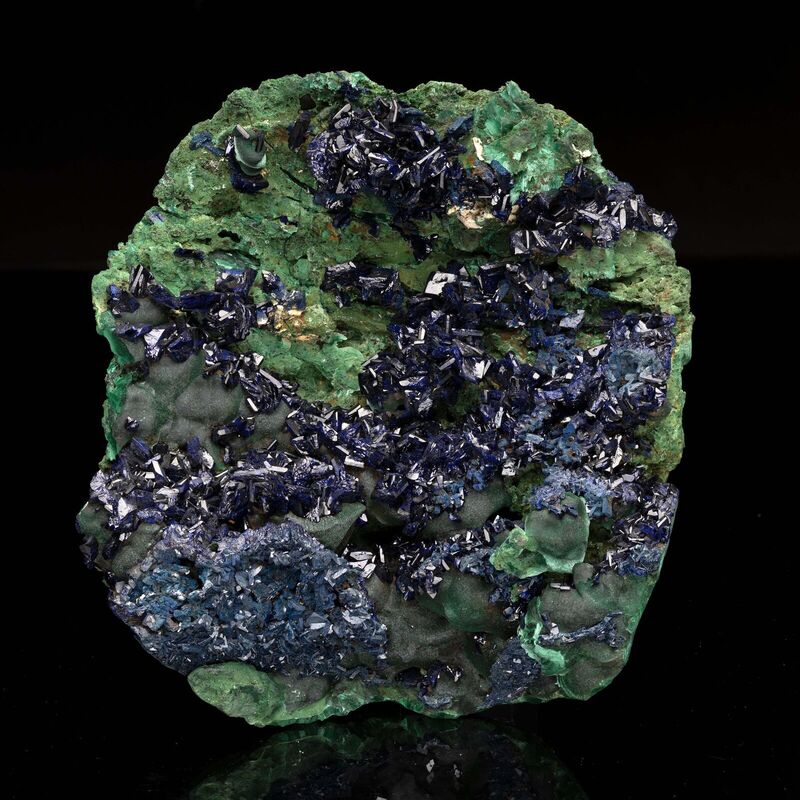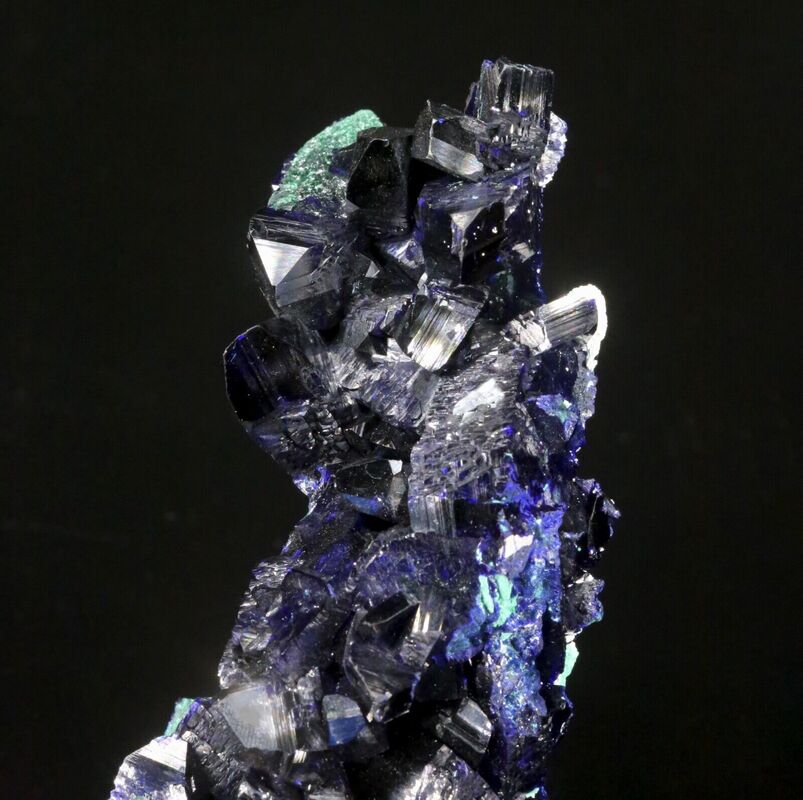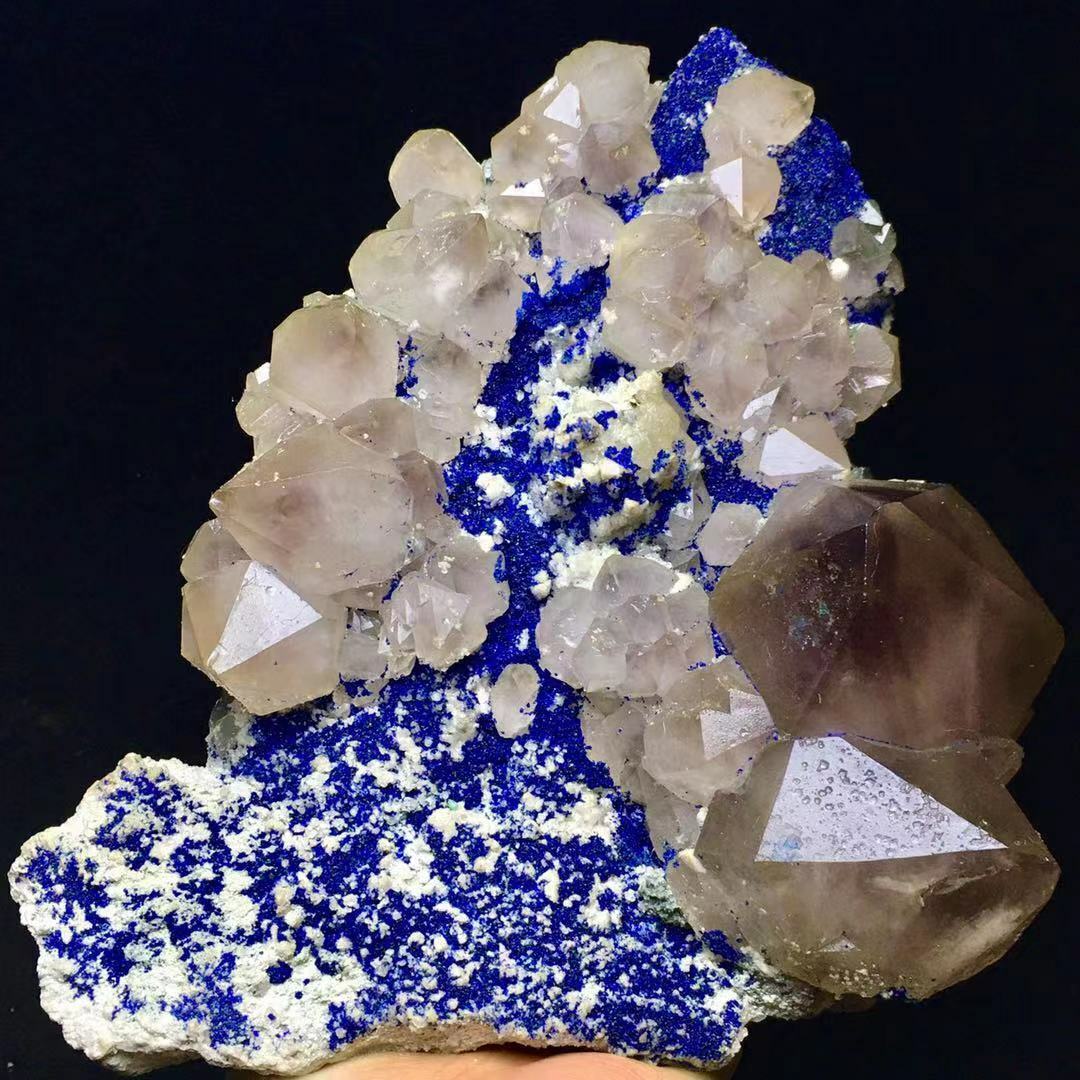Azurite
By Bob Farrar
by Bob Farrar
The September Mineral of the Month is azurite. Named for the Persian word for blue, lazuward, azurite is a favorite among mineral collectors. Pieces with good color and well-developed crystals are particularly sought after. Azurite is a basic copper carbonate, Cu3(OH)2(CO3)2. It is very similar in composition to malachite, which is Cu2CO3(OH)2. The two minerals often occur together; the oxidative state of the copper determines which one forms. Azurite crystalizes in the monoclinic system. Crystals may be elongated and prismatic, or more equant (equidimensional). Massive azurite, crusts, and earthy material are also common. Most azurite appears opaque or nearly so, but well-formed crystals can be transparent and inky blue with a strong light behind them. Like other carbonates, it fizzes in acid. Other physical properties include a hardness of 3.5 to 4, glassy luster, and a specific gravity of 3.8. Most other blue minerals are harder, and effervescence in acid distinguishes it from other blue copper minerals. Azurite typically occurs in the weathered, oxidized zones of copper deposits. Good localities are many. Among the finest azurite crystals ever found, up to 15 cm long, came from Tsumeb, Namibia several years ago. Excellent azurite crystals have been found at Touissit, Morocco. At Kerrouchen, Morocco, single crystals in the 2-to-3-cm range, as well as clusters of small crystals, occur in cavities in limestone, possibly deposited there by copper solutions from a nearby basalt formation. “Azurite suns” are flattened discs of azurite in a white kaolin found at the Malbunka Mine in Northern Territories, Australia. Many other localities in Africa, China, Brazil, and Europe produce good azurites. In the United States, there are many important azurite localities. Particularly famous are Bisbee, and Ajo, AZ, and other copper-mining areas in the Southwest. Spherical, radiating specimens are found at La Sal, UT. A little closer to home, crusts and seams of azurite can be found in the old copper mines of the Virgilina area of VA and NC, as well as at Rossville, PA. In Maryland, azurite has been found at old copper localities, such as Bare Hills in Baltimore Co., and the Roop Mine in Carroll Co. Azurite has been used as an ore of copper, but it is of minor importance in this respect. It has also been used for centuries as a pigment. Azurite can be polished, but in lapidary work it is most often seen in mixtures of other copper minerals and silica that can make pretty cabochons. It is of greatest interest, though, as a mineral specimen. Large, well-formed crystals, especially from famous localities like Tsumeb, Namibia, can fetch very high prices. However, lesser specimens are common enough that just about anyone can afford to add azurite to their collection.
The September Mineral of the Month is azurite. Named for the Persian word for blue, lazuward, azurite is a favorite among mineral collectors. Pieces with good color and well-developed crystals are particularly sought after. Azurite is a basic copper carbonate, Cu3(OH)2(CO3)2. It is very similar in composition to malachite, which is Cu2CO3(OH)2. The two minerals often occur together; the oxidative state of the copper determines which one forms. Azurite crystalizes in the monoclinic system. Crystals may be elongated and prismatic, or more equant (equidimensional). Massive azurite, crusts, and earthy material are also common. Most azurite appears opaque or nearly so, but well-formed crystals can be transparent and inky blue with a strong light behind them. Like other carbonates, it fizzes in acid. Other physical properties include a hardness of 3.5 to 4, glassy luster, and a specific gravity of 3.8. Most other blue minerals are harder, and effervescence in acid distinguishes it from other blue copper minerals. Azurite typically occurs in the weathered, oxidized zones of copper deposits. Good localities are many. Among the finest azurite crystals ever found, up to 15 cm long, came from Tsumeb, Namibia several years ago. Excellent azurite crystals have been found at Touissit, Morocco. At Kerrouchen, Morocco, single crystals in the 2-to-3-cm range, as well as clusters of small crystals, occur in cavities in limestone, possibly deposited there by copper solutions from a nearby basalt formation. “Azurite suns” are flattened discs of azurite in a white kaolin found at the Malbunka Mine in Northern Territories, Australia. Many other localities in Africa, China, Brazil, and Europe produce good azurites. In the United States, there are many important azurite localities. Particularly famous are Bisbee, and Ajo, AZ, and other copper-mining areas in the Southwest. Spherical, radiating specimens are found at La Sal, UT. A little closer to home, crusts and seams of azurite can be found in the old copper mines of the Virgilina area of VA and NC, as well as at Rossville, PA. In Maryland, azurite has been found at old copper localities, such as Bare Hills in Baltimore Co., and the Roop Mine in Carroll Co. Azurite has been used as an ore of copper, but it is of minor importance in this respect. It has also been used for centuries as a pigment. Azurite can be polished, but in lapidary work it is most often seen in mixtures of other copper minerals and silica that can make pretty cabochons. It is of greatest interest, though, as a mineral specimen. Large, well-formed crystals, especially from famous localities like Tsumeb, Namibia, can fetch very high prices. However, lesser specimens are common enough that just about anyone can afford to add azurite to their collection.



